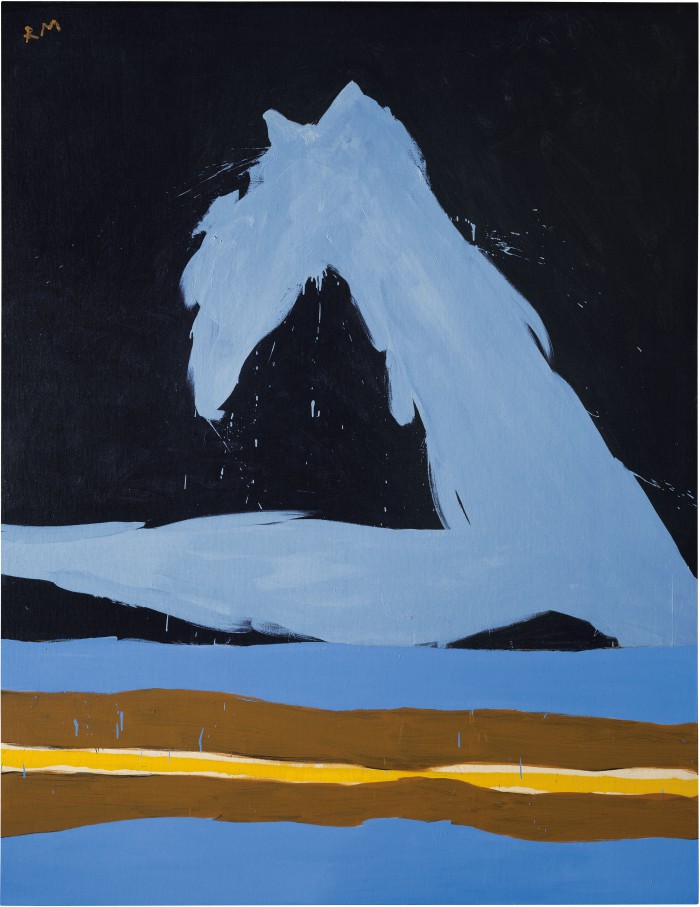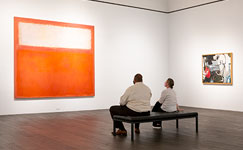Robert Motherwell
Italian Summer 1963

Art © Dedalus Foundation, Inc./Licensed by VAGA, New York, NY. Reproduction of this image, including downloading, is prohibited.
Audio Description (02:57)
Full Audio Transcript (Expand)
Italian Summer
Italian Summer from 1963 is one of 64 paintings in Robert Motherwell’s “Beside the Sea” series. These were inspired by his view of the Atlantic Ocean out a window in Provincetown, Massachusetts. The painting is seven-and-a-half feet tall by nearly six feet wide. Even at this size, it feels as if it can barely contain a rushing blast of water from a wave that dominates the image. The wave crests high above an otherwise placid sea on a starless night.
The night sky fills the top two thirds of the painting. It is black and punctuated by foggy, pale blue smudges here and there. The bottom third shows the very narrow stretch of land on which Provincetown is situated: a slice of beach hugged on both sides by the sea. The painting does not use perspective or attempt to represent the beach literally. A real view of a beach out a window would start with sand, with the water further in the distance. Here, the sand is just a wavering band of gold and beige. It is sandwiched between two stripes of muddy brown about twice as thick as the gold and beige. The muddy brown is then sandwiched between two slightly thicker periwinkle blue stripes for water. Both stripes are calm and very smooth in texture. Slender drips and streaks of blue punctuate the beach.
The star of this artwork is the wave. It is painted sideways to the beach instead of heading toward it. This better demonstrates its size and force, even if unrealistic. It begins with pale blue water streaked with white that lunges across the top of the spit of land and the stripes of sea. This surface water is so fierce that it rises above the rest of the sea in places. In these gaps, the night sky peeks through. From the right edge of the painting, the wave shoots up from the surface water at a 45-degree angle toward the left. This huge wave nearly reaches the top of the painting before peaking. The paint is applied much thicker to the wave than the still water. Overlapping, rough brush strokes and sometimes small globs of paint distinguish it. The wave is caught just at the moment it is cresting, when its blue-white water begins to tumble back down. Small drips and splatters of light blue paint thrust off the wave into the air. They drip downward by the force of the rolling wave. The drops come off of all parts of the wave except the very top peak.
In the upper left corner of the panel, Motherwell painted his initials in the same gold paint as the beach. They glimmer high in the dark sky. Even the effervescent sprays of salt water coming off the giant wave cannot touch them.
Robert Motherwell spent the summer of 1962 at an artist’s colony in Provincetown, Massachusetts. His paintings of the early 1960s are inspired by the view from his studio window – waves crashing on the beach of the Atlantic coast.
In 1962, Robert Motherwell and Helen Frankenthaler spent the summer at the artists’ colony at Provincetown, Massachusetts, where the coastline inspired the “Beside the Sea” series of 64 paintings. In this series, the oil paint was splashed with full force against rag paper imitating the sea crashing on the shore in front of his studio. Italian Summer, made in 1963, is a part of the “Beside the Sea” painting series.
-Abhi Singh







